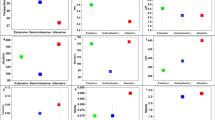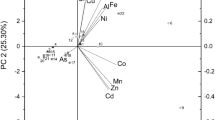Abstract
The composition of selected biogenic amines, pH, psychrophilic and mesophilic bacterial loads in orange-spotted grouper kept in ice were investigated for 18 days. Fish weighing 800.15 ± 196.85 g were purchased immediately following capture with no eviscerating. In each experimental time, three random fish were withdrawn and each biogenic amine, including histamine, putrescine, cadaverine and tyramine were determined in triplicate using HPLC technique. Although the obtained data showed significant increasing trends (p < 0.05) for all measured amines, the cadaverine was not detected significantly. In addition, there were no detectable biogenic amines initially. However, the highest value for histamine was attributed to 70.37 μg. g−1 of fish muscle obtained at 12th days of storage. The initial (day 0) concentrations were 3.22 and 2.96 μg. g−1 and the maximum levels were obtained 19.87 and 14.37 μg.g−1 for putrescine and tyramine respectively. Biogenic amine index also rises from 0.15 up to 62.57 during 18 days of ice storage. The increases in pH, psychrophilic and mesophilic bacteria loads were significant (p < 0.05) as storage time progressed. In this respect, psychrophilic bacteria were considered as dominant microorganism during ice storage of orange-spotted grouper. The best correlation was also observed between tyramine and mesophilic bacteria (r = 0.977, p < 0.001). Although the amounts of biogenic amines were increased during this study, these levels were not exceeded than that of reported as allowable level for human consumption. The results suggest that the control of storage conditions and bacterial presence might play an important role to hider the formation of biogenic amines in fish meat.


Similar content being viewed by others
References
Al Bulushi I, Poole S, Deeth HC, Dykes GA (2009) Biogenic amines in fish: roles in intoxication, spoilage, and nitrosamine formation—a review. Crit Rev Food Sci Nutr 49(4):369–377
Alberto MR, Arena ME, Manca de Nadra MC (2002) A comparative survey of two analytical methods for identification and quantification of biogenic amines. Food Control 13:125–129
American Public Health Association (APHA) (1984) Compendium of methods for the microbiological examination of foods, 2nd edn. APHA, Washington, DC
Anderson AA (2008) Biogenic and volatile amine-related qualities of three popular fish species sold at Kuwait fish markets. Food Chem 107:761–767
Ayesh AM, Ibraheim MN, El-Hakim AE, Mostafa EAH (2012) Exploring the contamination level by biogenic amines in fish samples collected from markets in Thuel—Saudi Arabia. Afr J Microbiol Res 6(6):1158–1164
Bakar J, Yassoralipour A, Abu Bakar F, Abdul Rahman R (2010) Biogenic amine changes in barramundi (Lates calcarifer) slices stored at 0° C and 4° C. Food Chem 119:467–470
Bardocz S (1995) Polyamines in food and their consequences for food quality and human health. Trends Food Sci Technol 6:341–346
Campos CA, Rodriguez O, Losada V, Aubourg SP, Barros-Velaquez J (2005) Effects of storage in ozonised slurry ice on the sensory and microbial quality of sardine (Sardina pilchardus). Int J Food Microbiol 103:121–130
Chytiri S, Paleologos E, Savvaidis I, Kontominas MG (2004) Relation of biogenic amines with microbial and sensory changes of whole and filleted freshwater rainbow trout (Onchorynchus mykiss) stored on ice. J Food Protect 67(5):960–965
Dawood AA, Karkalas J, Ray RN, Williams CS (1988) The occurrence of non-volatile amine in chilled stored Rainbow trout (Salmo irideus). Food Chem 27:33–45
USFDA (US Food and Drug Administration) (2001) Scombrotoxin (histamine) formation. In: Fish and fishery products hazards and controls guide, 3rd ed. Washington, DC: Department of Health and Human Services, Public Health Service, Food and Drug Administration, Center for Food Safety and Applied Nutrition, Office of Seafood
Esaiassen M, Nilsen H, Joensen S, Skjerdal T, Carlehog M, Eilertsen G, Gundersen B, Elvevoll E (2004) Effects of catching methods on quality changes during storage of cod (Gadus morhua). Lebensm Wiss Technol 37:643–648
FAO (2010) Cultured Aquatic species information programme. Epinephelus coioides. Cultured aquatic species information programme. Text by Shams AJ in: FAO Fisheries and Aquaculture Department. Rome
Gram L, Huss HH (1996) Microbiological spoilage of fish and fish products. Int J Food Microbiol 33:121–137
Huss HH, Ababouch L, Gram L (2003) Assessment and management of seafood safety and quality. FAO Fisheries Technical Paper No. 444. Rome, FAO
ISIRI (1999) Permitted limit of microbial pollution in meat, 2nd edn. Institute of Standard and Industrial Research of Iran, No 2394
ISIRI (2001) The counting methods of psychrophilic and psychrotrophic bacteria, 2nd edn. Institute of Standard and Industrial Research of Iran, No 2625
Kim SH, Barros-Velazquez J, Ben-Gigirey B, Eun JB, Jun SH, Wei C, An H (2003) Identification of the main bacteria contributing to histamine formation in seafood to ensure product safety. Food Sci Biotechnol 12:451–460
Kim M-k, Mah J-H, Hwang H-J (2009) Biogenic amine formation and bacterial contribution in fish, squid and shellfish. Food Chem 116:87–95
Kimata M (1961) In: Borgstrom G (ed) Fish as food: production, biochemistry and microbiology, vol 1. Academic, New York
Klausen NK, Huss HH (1987) Growth and histamine production by Morganella morganii under various temperature conditions. Int J Food Microbiol 5:147–156
Krizek M, Vacha F, Vorlova L, Lukasova J, Cupakova S (2004) Biogenic amines in vacuum-packed and non-vacuum packed flesh of Carp (Cyprinus carpio) stored at different temperatures. Food Chem 88:185–191
Kuley S, Özogul F, Özogul Y (2005) Effects of aluminium foil and cling film on biogenic amines and nucleotide degradation products in gutted sea bream storedat2±1°C. Eur Food Res Technol 221:582–591
Mietz JL, Karmas E (1977) Chemical quality index of canned tuna as determined by high-pressure liquid chromatography. J Food Sci 42:155–158
Moini S, Sotoodeh AM, Haghoo A, Moslemi M, Hosseini SV, Regenstein JM, Sanchez XF, Aflaki F, Yadollahi F (2012) Changes in biogenic amines and bacteria of tiger-toothed croaker (Otolithes ruber) during ice storage. J Aquat Food Prod Tech 21(2):147–155
Naila A, Flint S, Fletcher G, Bremer P, Meerdink G (2010) Control of biogenic amines in food–existing and emerging approaches. J Food Sci 75(7):R139–R150
Ntzimani AG, Paleologos EK, Savvaidis IN, Kontominas MG (2008) Formation of biogenic amines and relation to microbial flora and sensory changes in smoked turkey breast fillets stored under various packaging conditions at 4 degrees C. Food Microbiol 25(3):509–517
Olafsdottir G, Lauzon HL, Martinsdottir E, Kristbergsson K (2006) Influence of storage temperature on microbial spoilage characteristics of haddock fillets (Melanogrammus aeglefinus) evaluated by multivariate quality prediction. Int J Food Microbiol 11:112–125
Onal A (2007) A review: current analytical methods for the determination of biogenic amines in foods. Food Chem 103:1475–1486
Özogul Y, Özogul F (2006) Effects of slaughtering methods on sensory, chemical and microbiological quality of rainbow trout (Onchorynchus mykiss) stored in ice and MAP. Eur Food Res Technol 219:211–216
Özogul F, Özogul Y, Kuley E (2008) Nucleotide degradation and biogenic amine formation of wild white grouper (Epinephelus aeneus) stored in ice and at chill temperature (4°C). Food Chem 108:933–941
Özyurt G, Kuley E, Özkütük S, Özogul F (2009) Sensory, microbiological and chemical assessment of the freshness of red mullet (Mullus barbatus) and goldband goatfish (Upeneus moluccensis) during storage in ice. Food Chem 114:505–510
Pacheco-Aguilar R, Lugo-Sanchez ME, Robles-Burgueno MR (2000) Postmortem biochemical and functional characteristic of Monterey sardine muscle stored at 0 °C. J Food Sci 65:40–47
Park JS, Lee CH, Kwon EU, Lee HJ, Kim JY, Kim SH (2010) Monitoring the contents of biogenic amines in fish and fish products consumed in Korea. Food Control 21:1219–1226
Rawles DD, Flick GJ, Martin RY (1996) Biogenic amines in fish and shellfish. Adv Food Nutr Res 39:329–365
Rezaei M, Montazeri N, Langrudi HE, Mokhayer B, Parviz M, Nazarinia A (2007) The biogenic amines and bacterial changes of farmed rainbow trout (Oncorhynchus mykiss ) stored in ice. Food Chem 103:150–154
Rivas B, Gonzalez R, Landete JM, Munoz R (2008) Characterization of a second ornithine decarboxylase isolated from Morganella morganii. J Food Prot 71(3):657–661
Ruiz-Capillas C, Jiménez-Colmenero F (2004) Biogenic amines in meat and meat products. Crit Rev Food Sci Nutr 44(7–8):489–499
Ruiz-Capillas C, Moral A (2002) Effect of controlled and modified atmospheres on the production of biogenic amines and free amino acids during storage of hake. Eur Food Res Technol 214:476–481
Staruszkiewicz WF, Barnett JD, Rogers PL, Benner RA Jr, Wong LL, Cook J (2004) Effects of on-board and dockside handling on the formation of biogenic amines in mahi-mahi (Coryphaena hippurus), skipjack tuna (Katsuwonus pelamis), and yellowfin tuna (Thunnus albacares). J Food Prot 67:134–141
Taylor SL, Summer S (1986) In: Kramer DE, Liston J (eds) Seafood quality determination. Elsevier, Amesterdam
Ten Brink B, Damnic C, Joosten HMLJ, Veld JH Hi’t (1990) Occurrence and formation of biologically active amines in foods. Int J Food Microbiol 11:73–84
Veciana-Nogues MT, Bover-Cid S, Marine-Font A, Vidal-Carou MC (2004) Biogenic amine production by Morganella morganii and Klebsiella oxytoca in tuna. Eur Food Res Technol 218:284–288
Vinci G, Antonelli ML (2002) Biogenic amines: quality index of freshness in red and white meat. Food Control 13:519–524
Visciano P, Schirone M, Tofalo R, Suzzi G (2012) Biogenic amines in raw and processed seafood. Front Microbiol 3:188. doi:10.3389/fmicb.2012.00188
Yeh SL, Kuo CM, Ting YY, Chang CF (2003) Androgens stimulate sex change in protogynous grouper, Epinephelus coioides: spawning performance in sex-changed males. Comp Biochem Physiol, Part C: Toxicol Pharmacol 135:375–382
Yongjin H, Wenshui X, Xiaoyong L (2007) Changes in biogenic amines in fermented silver carp sausages inoculated with mixed starter cultures. Food Chem 104:188–195
Yoshinaga DH, Frank HA (1982) Histamine-producing bacteria in decomposing skipjack tuna (Katsuwonus pelamis). Appl Environ Microbiol 44:447–452
Acknowledgment
We thank all of our colleagues that support us during the study and Professor A A Moshtaghie from Isfahan University of Medical Sciences for reviewing the paper. We would also like to give our appreciations to unknown reviewers for their careful reading and insightful suggestions.
Conflict of interest
The authors declare that they have no conflict of interest.
Author information
Authors and Affiliations
Corresponding author
Rights and permissions
About this article
Cite this article
Bita, S., Malekpouri, P., Mohammadian, T. et al. Changes in biogenic amines and microbial loads in the muscle of orange-spotted grouper, Epinephelus coioides (Hamilton, 1822) during ice storage. J Food Sci Technol 52, 240–248 (2015). https://doi.org/10.1007/s13197-013-0973-3
Revised:
Accepted:
Published:
Issue Date:
DOI: https://doi.org/10.1007/s13197-013-0973-3




